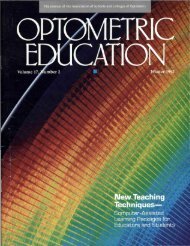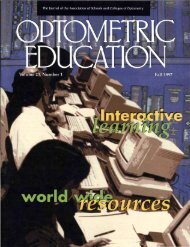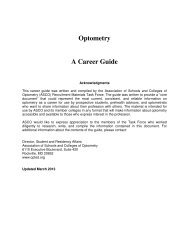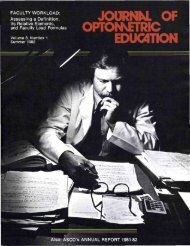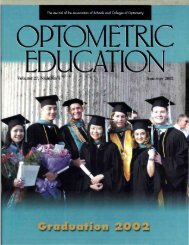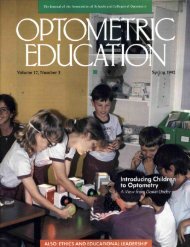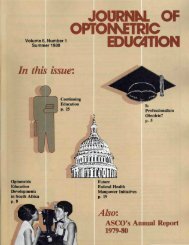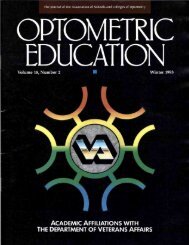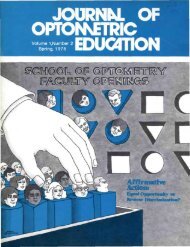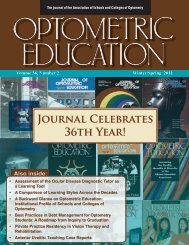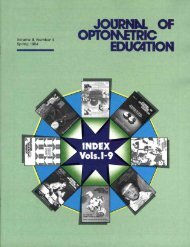Summer 2012, Volume 37, Number 3 - Association of Schools and ...
Summer 2012, Volume 37, Number 3 - Association of Schools and ...
Summer 2012, Volume 37, Number 3 - Association of Schools and ...
Create successful ePaper yourself
Turn your PDF publications into a flip-book with our unique Google optimized e-Paper software.
CLINICAL ETHICS<br />
An Ethical Dilemma<br />
in Modern Optometry<br />
ASCO Student Award in Clinical Ethics<br />
Daniel Harker<br />
As optometry’s scope <strong>of</strong> practice exp<strong>and</strong>s,<br />
the myriad <strong>of</strong> ethical challenges<br />
facing eyecare practitioners multiplies.<br />
The pr<strong>of</strong>ession <strong>of</strong> optometry adheres<br />
to several ethical theories <strong>and</strong> values<br />
to protect the welfare <strong>and</strong> health <strong>of</strong><br />
the public. Among these are the virtue<br />
theory <strong>and</strong> theories <strong>of</strong> consequentialism.<br />
As well, optometrists uphold ethical<br />
values such as responsibility, charity,<br />
fidelity <strong>and</strong> integrity. With these<br />
st<strong>and</strong>ards in place, optometrists are<br />
held accountable for their actions <strong>and</strong><br />
regarded as pr<strong>of</strong>essionals in the healthcare<br />
industry. These ethical theories<br />
<strong>and</strong> values were challenged in this case<br />
from a Veterans Administration health<br />
center in Texas. The patient in the case,<br />
a 68-year-old Hispanic male, admitted<br />
to being physically abused by his<br />
spouse, but stated he did not want to<br />
press charges or legally pursue the matter.<br />
The situation was analyzed, <strong>and</strong> a<br />
decision was reached on how to h<strong>and</strong>le<br />
the issue in an ethical manner.<br />
An Unremarkable<br />
Examination<br />
On March 15, <strong>2012</strong>, the patient presented<br />
for an appointment at the health<br />
center. He had no ocular complaints,<br />
<strong>and</strong> the ocular exam did not reveal anything<br />
out <strong>of</strong> the ordinary. The anterior<br />
segment appeared normal. No bruising,<br />
subconjunctival hemorrhages or<br />
traumatic cataracts were observed. The<br />
posterior pole also appeared to be normal.<br />
There were no signs <strong>of</strong> commotio<br />
retinae or abuse. Visual acuity was<br />
20/25 in each eye. (No cuts, bruises or<br />
swelling were seen on the body.)<br />
An Unexpected Disclosure<br />
As the patient was selecting new spectacle<br />
frames, it was noted that his old<br />
frames were bent out <strong>of</strong> shape. When<br />
asked about the condition <strong>of</strong> his spectacles,<br />
the patient hesitated for a moment<br />
<strong>and</strong> then confided that his wife occasionally<br />
beats him <strong>and</strong> the bent glasses<br />
were a direct result <strong>of</strong> these beatings. He<br />
went on to state that he did not want<br />
to report the abuse, fearing his wife<br />
would face legal action. This presented<br />
a serious ethical dilemma: Should the<br />
patient’s wishes be respected, or should<br />
the alleged abuse be reported to those<br />
with proper authority to deal with the<br />
matter?<br />
Making a Decision<br />
Several ethical theories were considered<br />
before a firm decision was made. According<br />
to theories <strong>of</strong> consequentialism,<br />
“an action is right if it promotes<br />
the best consequences.” 1 The best consequence<br />
in this case is subjective. From<br />
the patient’s point <strong>of</strong> view, the best<br />
consequence would be to avoid punishment<br />
<strong>and</strong> legal strife with his wife.<br />
On the other h<strong>and</strong>, the eyecare practitioner<br />
could view the situation from a<br />
completely different perspective. If the<br />
abuse were to continue, further physical<br />
harm <strong>and</strong> neglect could occur, leaving<br />
the patient’s body <strong>and</strong> mind damaged.<br />
The virtue theory was also contemplated.<br />
Based on this theory, an action<br />
is right if it is what a virtuous agent<br />
would do in the circumstances. A virtuous<br />
agent is bound by several ethical<br />
values, such as responsibility, charity, fidelity<br />
<strong>and</strong> integrity. A virtuous agent in<br />
this situation would want the best for<br />
the patient <strong>and</strong> his or her current <strong>and</strong><br />
future health. Furthermore, the ethical<br />
value <strong>of</strong> responsibility dem<strong>and</strong>s that a<br />
virtuous agent be accountable for his or<br />
her actions. Eyecare practitioners must<br />
be held accountable to the public for<br />
their decisions. The public dem<strong>and</strong>s<br />
that the case is reported to the proper<br />
authorities if certain people are experiencing<br />
abuse. In the state <strong>of</strong> Texas,<br />
the law requires “anyone who thinks a<br />
child, or person 65 years or older, or an<br />
adult with disabilities is being abused,<br />
neglected, or exploited must report it to<br />
DFPS (Department <strong>of</strong> Family <strong>and</strong> Protective<br />
Services).” 2 Because the patient<br />
in this case is over the age <strong>of</strong> 65, this<br />
law clearly must be followed, <strong>and</strong> the<br />
case must be reported.Those outside <strong>of</strong><br />
Texas jurisdiction should abide by their<br />
state’s law.<br />
Optometric Education 102 <strong>Volume</strong> <strong>37</strong>, <strong>Number</strong> 3 / <strong>Summer</strong> <strong>2012</strong>



